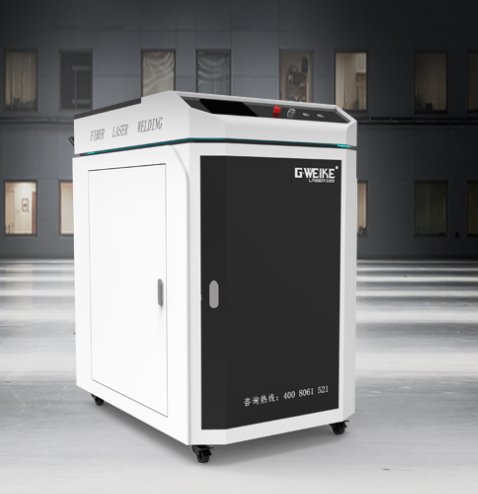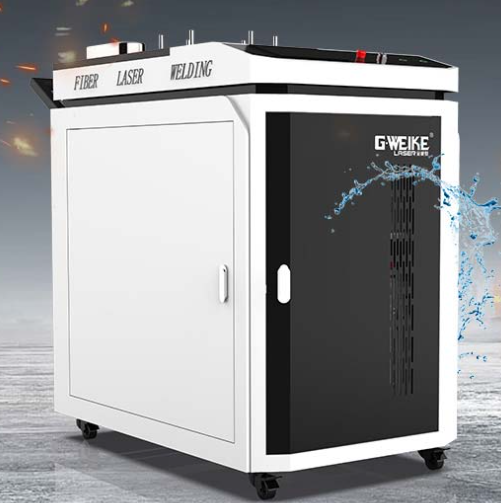Laser Welding Machine - Complete Guide
Conventional welding techniques such as traditional electric welding and argon arc welding are no longer adequate for commercial metal welding production. This is because these conventional welding techniques tend to produce metal welds with galling edges and imperfections.
The Laser welding machine is a new type of welding machine that makes the weld more aesthetically pleasing and free of cracks and porosity. You can use this technology to weld most metals at high speed and no consumables. And as technology continues to innovate, multifunctional welding machines such as hand-held welding machines and welding cleaning machines are available.
Let's learn more about welding machines together next!
- What is laser welding?
- How laser welding machines work
- Features of the laser welder machine
- Pros and cons of laser welding technology
- Classification of laser welding machines
- Structure of laser welding machines
- Factors affecting the quality of laser welding
- Types of metal to be welded by laser welding machines
- Laser welder machine recommendations
- How much does a handheld laser welding machine cost?
- Applications of laser welding machines
What is laser welding?
In simple terms, Laser welding is a technique for joining metal materials with laser light. The welding speed is also very high due to the very concentrated heat source of the laser beam. Laser welding is used to weld two identical materials as far as possible. It is a non-contact welding process in which the material is mainly melted by the laser and the melted material solidifies to achieve the welding effect. The welding results vary from the laser welding machine to the laser welding machine.
How to choose
The choice of laser welding machine is closely related to the thickness of the material you are welding. There are two types of lasers in common use today: pulsed and continuous lasers.
Pulsed lasers:
- The best choice for welding thin metals
- Mainly used for welding jewelry, thin metal tubes, plates, etc.
- Continuous laser
- The best choice for welding thick metals
- Longer service life
- Ideal for welding thick metals, e.g. construction steel
- The high price of continuous lasers
- Tendency to over-weld gaps, distortion, and even direct melting of the metal when welding thin metals
How laser welding machines work
The laser welder machine works by focusing the laser beam onto the welding head via an optical element, the whole process is very complex. In simple terms, the pump light absorbs rare earth ions in the optical fiber and the rare earth electrons are then excited to higher excitation energy levels. The resulting laser light is then transmitted through the optical fiber to the welding head. Of course, the more specific outgoing light process is beyond my knowledge, so if you are interested you can consult with our engineers online.
In simple terms, the principle of welding is to use the high temperature of the laser to instantly melt the metal and then solidify it within seconds to complete a fast weld. This is the reason why we cannot touch the welded surface with our hands immediately after welding. There is a lot of heat left on the surface of the metal that has just been welded and direct contact can damage the skin.
Features of the laser welder machine
- Small welding seams and high precision
- The welding machines are more flexible, especially handheld laser welding machines.
- The laser welding machine has low environmental requirements
- Suitable for welding refractory materials, e.g. titanium alloys
- No contact welding, no part loss
Pros and cons of laser welding technology
- Intelligent computer control and a high degree of automation make it easier to control the machine
- Durable welding seam integrated into the metal part
- Fast welding speed, suitable for industrial mass production
- One successful pass, no secondary processing required
- Suitable for almost all metals, so widely used in dentistry, pcb, electronics, automotive parts, and other industries
- Small weld seams and smooth surfaces
- Non-contact welding, no material loss
- Precise welding of metal parts of all shapes, angles, and positions
- Particularly suitable for welding small precision parts, such as earrings, pcb, etc.
Of course, laser welding machines also have some cons:
- Expensive to purchase and high maintenance costs
- Improper handling may result in raised welds, which need to be polished manually afterward
- Not suitable for welding highly reflective metals
Classification of laser welding machines
Above we have mentioned the classification of lasers for laser welder machines. Normally we can classify them according to the laser source.
Currently, we can classify metal laser welding machines according to the laser source into three types:
CO2 laser welding machines
CO2 laser welding machines mainly use alternating currents to excite a gas mixture in the tube. This type of laser source belongs to the category of continuous lasers and is suitable for welding thick metals and non-metals.
Fiber laser welding machines
It produces a small and sharp beam of light that is capable of penetrating. It is therefore suitable for welding thick metals and is one of the most accurate welding techniques for welding metals.
YAG laser welding machine
This is a less energy-efficient welder and is suitable for welding small parts.
Structure of laser welding machines
The Laser welder machine consists of 4 main parts:
- The welder
The main function of the welder is to produce the laser beam for welding, consisting of the power supply, the control system, and the laser. - Cooling system
Like the laser cutter, the laser welder machine is also equipped with a cooling system. - Fixture
Are you wondering why a laser welding machine needs a fixture? Except for handheld metal laser welding machines, most welding machines are equipped with clamps to hold the welded parts in place. - Observation system
The viewing system of the welding machine supports the real-time observation of the workpiece, which is useful for observing the positioning during the welding process and the result after welding.
Factors affecting the quality of laser welding
Several factors affect the effectiveness of laser welding and you need to pay extra attention to the following parameters before using the welding machine.
Equipment Quality
The performance of the welding machine has a direct impact on the quality of the metal weld. The spot affects the width and depth of the weld. In general the lower the beam pattern order, the smaller the spot, i.e. the smaller the spot diameter. Smaller spots give better welding results. However, the spot size should not be too small. Otherwise, the spot will easily be contaminated during the welding process. I recommend that you choose a laser beam with a diameter of between 0.2 and 2 mm.
Again, the quality of the laser and the output power will affect the quality of the weld. The longer the wavelength, the lower the absorption and the less favorable it is for metal welding.
Quality of the metal weld
The quality of the welded part also has a direct influence on the welding result. If the metal part is rusty or the weld surface is not clean, this can make laser welding more difficult. After welding, lumps or gaps may appear, or even if there is too much metal in the weld, the welding may not be completed.
Welding parameters
The correct welding parameters ensure a more stable welding performance. First of all, check the pulse frequency, which is inversely proportional to pulse energy. The higher the frequency, the lower the welding efficiency.
The pulse waveform is also a very important parameter and you need to change the parameters in time depending on the type of metal to be welded.
Choosing a correct focal point position is also of great importance for the welding process.
The relationship between welding power and welding depth is proportional, approximately 0.7 times. However, the faster the welding speed, the less heat input will result in shallower welding depth.
Protective gas
The purpose of the shielding gas is to protect the workpiece from oxidation and to facilitate the timely blowing away of metal vapors. It also helps to cool the weld metal in time and speeds up the completion of the weld.
Types of metal to be welded by laser welding machines
Carbon Steel
There are many different types of carbon steel and the difficulty of welding varies depending on the level of impurities. You need to check the S and P content of the steel. These two elements have a direct impact on welding results. If the S and P content is too high, the weld will crack during the welding process. The lower the impurities, the better the weld
High carbon steels with a carbon content of 0.25% or more need to be preheated before welding if good welding results are to be obtained. If welding two carbon steels with different carbon contents, you can bias the torch towards the low-carbon side.
Stainless steels
Stainless steel is one of the most used alloys today and it is also a metal that is well suited to laser welding. The low thermal conductivity of stainless steel reduces the negative effects of high coefficient of linear expansion and overheating when laser welding. The low thermal conductivity and high melting efficiency of stainless steel also make it easier to achieve deep, narrow welds. By welding stainless steel with a metal laser welding machine, you can easily achieve a good quality weld. However, you should be aware that there are many different types of stainless steel, including 201, 316, 314, 409, etc., and that the welding parameters are different for each grade.
Alloy steels
Laser welding of high-strength steels requires the selection of suitable welding parameters.
Copper and copper alloys
Thermal cracking and porosity are the most common defects when welding copper and copper alloys with laser welder machines. If the welding of copper is not carried out properly, it is also easy to create problems with under-welding or under-fusion. When welding thin copper workpieces, that have little structural rigidity and are not protected against distortion, the chances of distortion after welding are high.
In conclusion, if you are not experienced in welding copper workpieces, it is advisable to pre-treat copper and copper alloy workpieces when using a handheld laser welding machine for the first time.
Aluminum and aluminum alloys
Aluminium is a highly reflective material and, as mentioned at the beginning of this article, laser welding machines are not suitable for welding highly reflective materials. Laser welding of aluminum is highly susceptible to defects and porosity, resulting in poor welding results.
Laser welder machine recommendations
Hanheld Metal Laser Welding Machine

| Machine Model | handheld metal laser welding machine |
|---|---|
| Laser Power | 1000W 2000W 3000W(optional) |
| laser wave length | 1070 NM |
| Fiber length | Standard10M / Maximum 15M |
| Welding speed range | 0~120 mm/s |
| Cooling chiller | Industrial water chiller |
| Working environment temperature range | 15~35 ℃ |
| Welding thickness recommendations | 0.5-3mm |
| working voltage | 220 V |
Handheld Laser Welding & Cleaning

| Laser power | 1000W 1500W 2000W (optional) |
|---|---|
| laser wave length | 1064nm |
| Fiber length | Standard10M / Maximum 15M |
| W0 | 0~120 mm/s |
| Cooling chiller | Industrial water chiller |
| Working environment temperature range | 15~35 ℃ |
| Welding thickness recommendations | 0.5-3mm |
| Working voltage | 220 V |
| Cleaning parameters | Cleaning width : 0-80mm |
| Focus height : 600mm |
How much does a handheld laser welder cost?
The market price for this ranges from a few thousand dollars to tens of thousands of dollars, with most being around $8000-19000. The price of a handheld laser welding machine varies greatly from brand to brand and parameter to parameter. You can choose a suitable laser welding machine according to your budget before you buy it.
Applications of laser welding machines
Laser welding machines are used in a wide range of applications, including jewelry manufacturing, construction sheet metal welding, automotive manufacturing, and many other industries.
A few common industries where laser welding machines are used are listed next:
Jewelry industry
Jewelry design is the industry where laser welding technology is most widely used. The best choice for welding bracelets, necklaces, earrings, etc. is to choose laser welding. Whether it is stainless steel, gold, silver, or a variety of other materials, the choice of laser welding is ideal. For very delicate jewelry, you can also choose to use a solder of the same material as the welding medium.
Automotive industry
Laser welding is chosen for components such as gears, powertrains, and transmission components in automobiles.
Medical industry
Laser welding is chosen for many instrument components in the medical industry, especially for welding dissimilar metals. Normally it would be difficult to weld two different types of metal together, a fiber laser welding machine can easily do this job.

